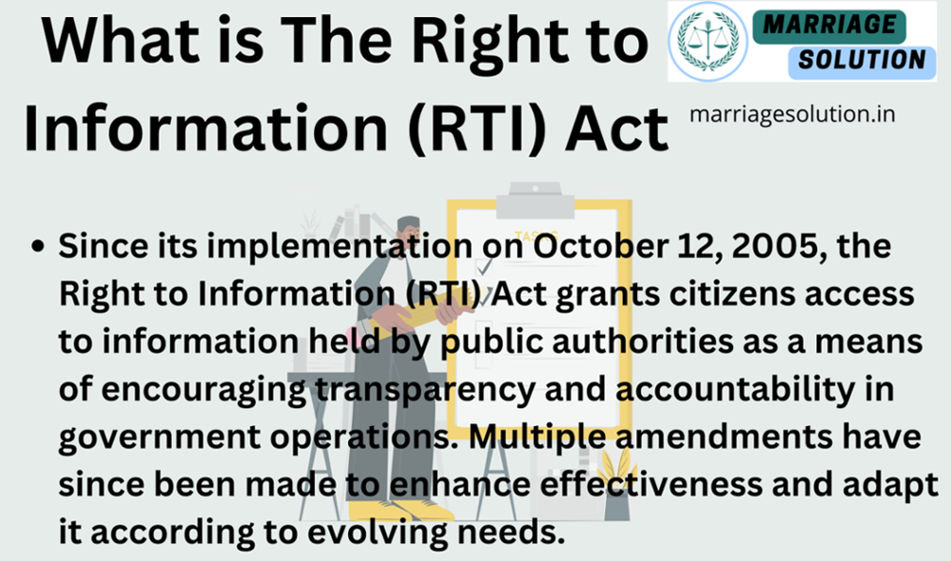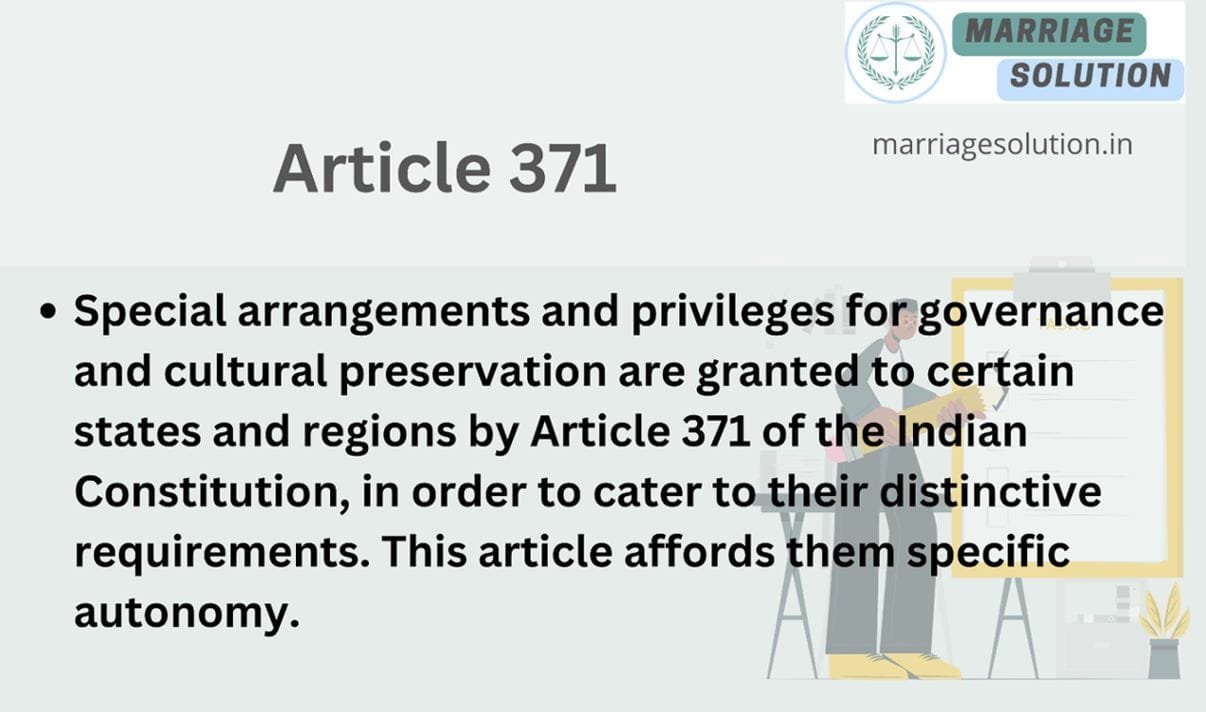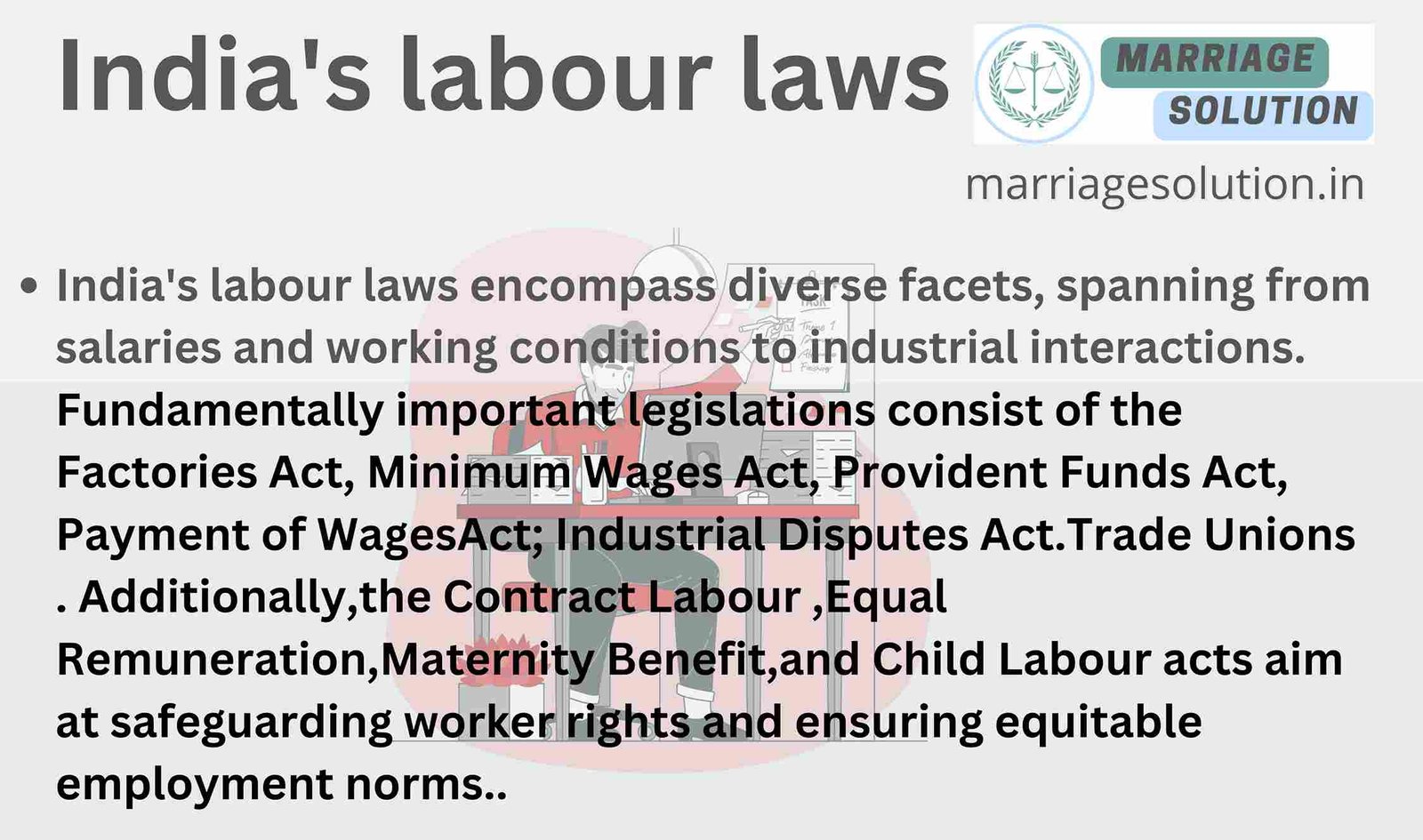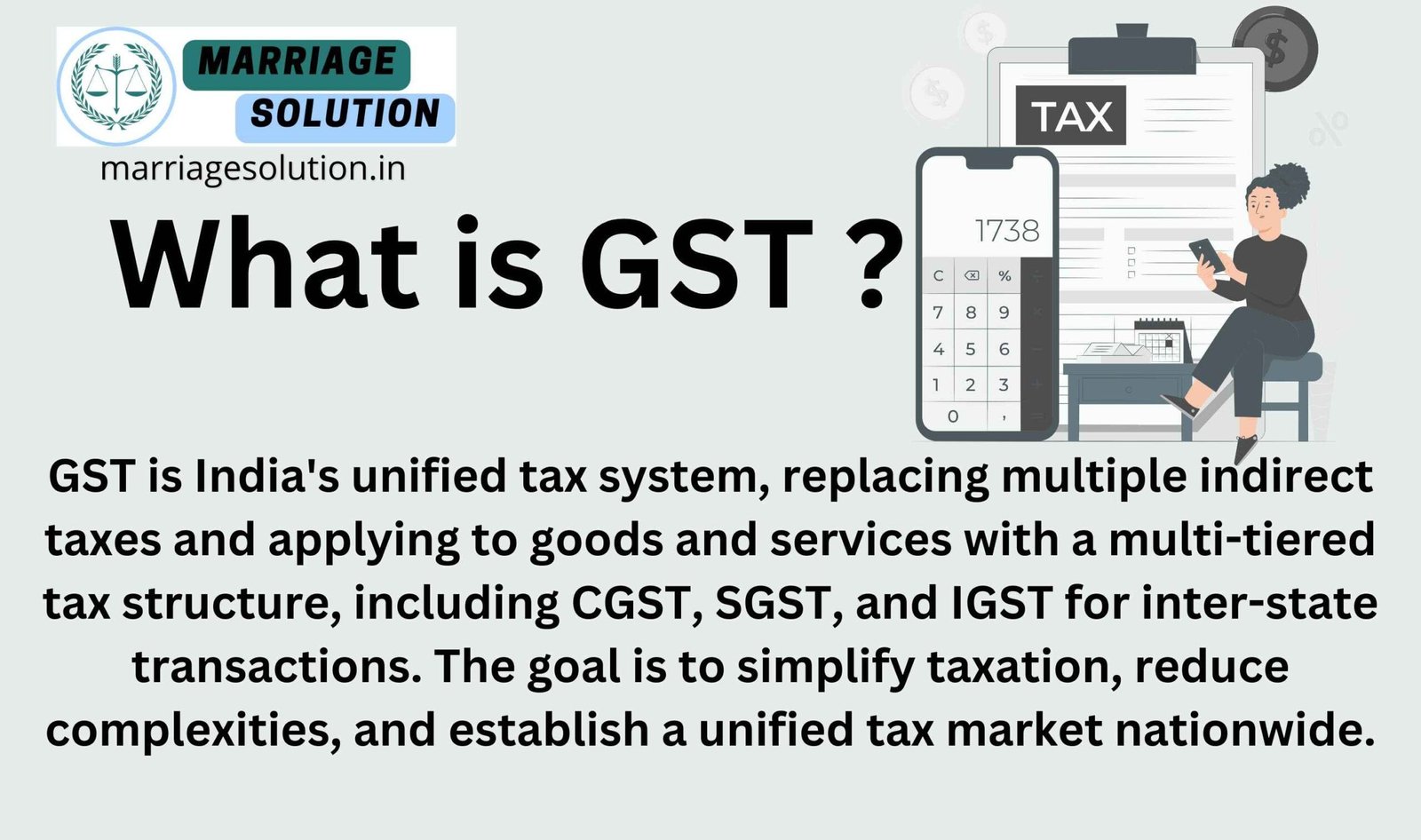Introduction of 150 IPC
IPC Section 150 deals with the recruitment of people for unlawful assemblies. If a person hires, influences, or encourages others to join a gathering that is likely to engage in criminal activities or disturb public peace, they can be punished under this section. Even if the unlawful act has not yet occurred, simply gathering people for such a purpose is an offense. This law helps prevent crimes before they happen by stopping the formation of dangerous groups.
- Introduction of 150 IPC
- What is IPC Section 150 ?
- Section 150 IPC in Simple Points
- IPC Section 150 Overview
- 10 Key Points on IPC Section 150
- 1. Understanding Unlawful Assembly
- 2. What IPC Section 150 Punishes
- 3. Requirement of Criminal Intention and Awareness
- 4. No Minimum Number of People Needed for Offense
- 5. Connection with Other IPC Sections
- 6. How Evidence is Collected in IPC 150 Cases
- 7. Where IPC 150 is Applied in Real Life
- 8. Defenses Against IPC 150 Charges
- 9. Impact on Right to Assemble
- 10. Preventive Nature of IPC 150
- Examples of IPC Section 150
- IPC 150 Punishment
- 150 IPC bailable or not ?
- Section 150 IPC case laws
- Section 150 IPC in short information
- 150 IPC FAQs
- If you need support with court proceedings or any other legal matters, don’t hesitate to reach out for assistance.
What is IPC Section 150 ?
IPC Section 150 punishes a person who hires, recruits, or engages others to form an unlawful assembly. An unlawful assembly means a group of five or more people gathered for an illegal purpose, such as violence, destruction of property, or obstructing law enforcement. The recruiter does not need to participate in the crime, but if they intentionally bring people together for unlawful purposes, they are guilty under IPC 150.

Section 150 IPC in Simple Points
1. What is an Unlawful Assembly?
IPC 150 is based on IPC Section 141, which defines an unlawful assembly as a group of five or more people gathered to commit an illegal act. This includes rioting, criminal trespass, or resisting law enforcement. If someone hires, recruits, or encourages others to join such a group, they can be punished under IPC 150.
2. Punishment for Hiring People for Unlawful Activities
If a person offers money, promises benefits, or convinces others to join an unlawful assembly, they can be punished under IPC 150. The law applies even if the recruited person does not actually commit any crime. The mere act of hiring or engaging someone for unlawful purposes is illegal.
3. Intent and Knowledge Matter
For an offense under IPC 150, the accused must have intended to form or support an unlawful assembly. They must have known that the gathering was illegal or likely to become unlawful. Even if they did not directly participate in the crime, they can still be held guilty for helping form the group.
4. No Minimum Number of People Required
IPC 150 does not specify a minimum number of people that must be recruited for the offense. Even if a person tries to hire just one person for an unlawful assembly, they can still be punished. However, the number of people recruited may be considered when deciding the punishment.
5. Connection with Other IPC Sections
IPC 150 is closely related to other sections dealing with unlawful assemblies (IPC 141-149). If a person hires others and also participates in the crime, they can be charged under multiple sections. The law ensures that both recruiters and active participants are punished for their role in unlawful gatherings.
IPC Section 150 Overview
IPC Section 150 is a preventive and punitive law that ensures individuals cannot legally hire or engage others for unlawful assemblies. By criminalizing the act of recruitment, this section helps maintain public order and prevents violent group activities. While it does not restrict lawful gatherings, its enforcement must be balanced to protect fundamental rights.
10 Key Points on IPC Section 150
1. Understanding Unlawful Assembly
An unlawful assembly is defined under IPC Section 141 as a group of five or more people gathered with a common intention to commit an illegal act. This includes resisting the police, causing damage (mischief), trespassing, or using force unlawfully. Even if the group does not take any action, just having the intent to break the law makes the assembly unlawful. The law is designed to prevent public disorder and criminal activities that can arise from such gatherings. IPC Section 150 deals specifically with the act of recruiting people into such unlawful assemblies.
2. What IPC Section 150 Punishes
IPC Section 150 punishes anyone who hires, engages, or influences others to join an unlawful assembly. The recruitment can be done through money, benefits, or even verbal persuasion. A person can be punished even if they do not personally participate in the unlawful assembly. The mere act of convincing or gathering people to join such a group is a criminal offense. This provision ensures that organizers and recruiters are held accountable, preventing large-scale violence or unlawful activities.
3. Requirement of Criminal Intention and Awareness
For a person to be punished under IPC 150, they must have had a criminal intention—meaning they knew they were gathering people for an unlawful act. The prosecution must prove that the accused was aware that the group was unlawful or could become unlawful. However, the recruiter does not need to know exactly what crime will be committed. For example, if a person gathers people for a protest that turns violent, they can still be charged even if they were unaware of the violence beforehand.
4. No Minimum Number of People Needed for Offense
IPC 150 does not specify that a large group must be recruited for it to be a crime. Even if someone attempts to recruit just one person, they can be punished. The focus of the law is on the act of recruiting, not on how many people were actually gathered. However, if a person recruits a large number of people, the punishment might be more severe. The law ensures that any attempt to form an unlawful gathering is stopped at an early stage.
5. Connection with Other IPC Sections
IPC 150 is closely related to IPC Sections 141 to 149, which define and punish unlawful assemblies and riots. While IPC 150 deals with the recruitment of people, Sections 142 to 149 punish the actual participation in an unlawful assembly. If a person recruits people and also joins the unlawful assembly, they can be charged under multiple sections of the IPC. This ensures that both organizers and participants face legal consequences for unlawful activities.
6. How Evidence is Collected in IPC 150 Cases
To convict a person under IPC 150, the police and prosecution must prove that they actively gathered people for unlawful purposes. Evidence can include:
- Witness statements from people recruited or others who saw the recruitment.
- Financial transactions if money was given as an inducement.
- Mobile messages, phone calls, or social media posts showing attempts to recruit people.
- Surveillance footage showing meetings or discussions about unlawful gatherings.
Even indirect evidence, such as frequent communication with unlawful groups, can be used in court.
7. Where IPC 150 is Applied in Real Life
IPC 150 is used in various situations, including:
- Violent protests where people are gathered to cause destruction.
- Mob violence where people are hired to attack or destroy property.
- Blocking roads or railways unlawfully to disrupt public services.
- Political rallies turning violent due to organized unlawful assemblies.
This section helps law enforcement prevent riots, violent demonstrations, or planned attacks by breaking down the recruitment process early.
8. Defenses Against IPC 150 Charges
A person accused under IPC 150 can defend themselves by proving:
- They did not know the assembly was unlawful.
- They were forced or threatened into gathering people.
- They were falsely accused due to mistaken identity.
If an assembly started lawfully but later turned unlawful, and the recruiter was unaware of this change, it could also be used as a defense. Courts carefully examine the intention and awareness of the accused before convicting them.
9. Impact on Right to Assemble
India’s Constitution guarantees the right to peaceful assembly, but IPC 150 ensures that gatherings do not turn violent or unlawful. The section does not ban lawful protests—it only targets those who gather people for criminal purposes. Courts must balance public safety and individual freedoms when applying this law. If used too broadly, it could restrict peaceful protests, so it must be enforced carefully.
10. Preventive Nature of IPC 150
IPC 150 plays a preventive role by allowing authorities to stop unlawful gatherings before they escalate. By targeting the organizers and recruiters, the law ensures that large-scale violence or criminal activities do not take place. Law enforcement can intervene early and prevent situations from becoming dangerous. This section acts as a deterrent for people trying to mobilize unlawful groups, ensuring peace and public order.
Examples of IPC Section 150
Example 1: Hiring People for a Violent Protest
A political leader offers money to unemployed youth to join a protest and destroy public property. The youth did not originally intend to commit a crime, but because they were recruited, they participated in an unlawful act. Even if the leader did not personally damage anything, he can be punished under IPC 150 for gathering people for an unlawful assembly.
Example 2: Gathering a Mob for a Land Dispute
A businessman hires 20 people to forcibly take over a disputed land. These people threaten the legal owner and try to remove him by force. The businessman never enters the property but is guilty under IPC 150 for recruiting people for an unlawful assembly. The recruited people may also be charged under IPC 141-149 for unlawful assembly and rioting.
IPC 150 Punishment
1. Imprisonment; A person convicted under IPC 150 can be punished with imprisonment for up to six months. The length of the sentence depends on how serious the unlawful activity was and whether the recruiter had a major role in gathering the group.
2.Fine: The court can impose a fine on the accused instead of or along with imprisonment. The amount of the fine is decided by the court based on the seriousness of the offense and the impact on public order.
3. Both Imprisonment and Fine :In some cases, the court may order both imprisonment and a fine to ensure strict punishment and discourage others from recruiting people for unlawful assemblies.
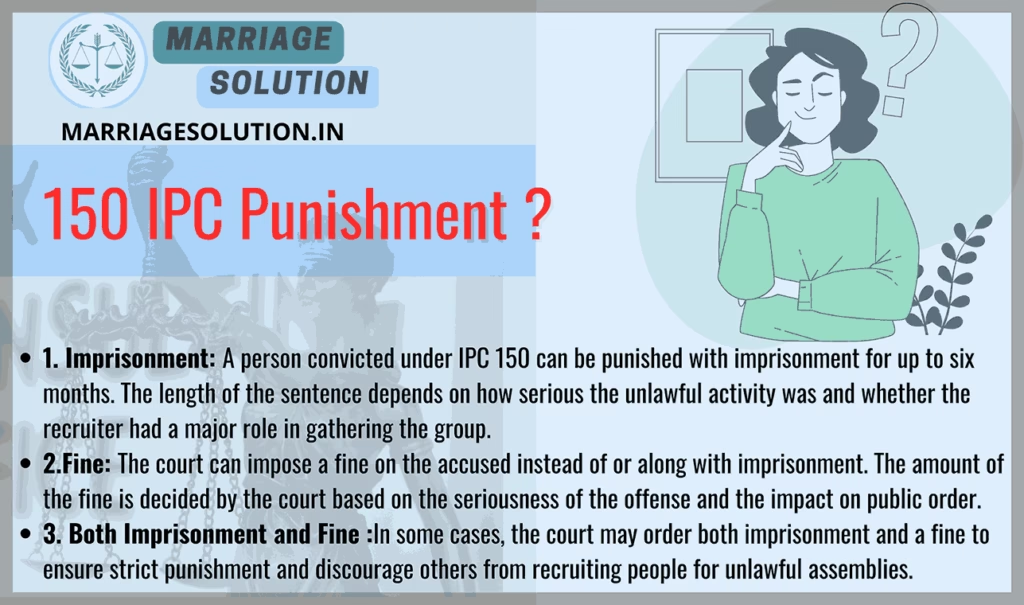
150 IPC bailable or not ?
IPC 150 is a non-bailable offense. This means that the accused does not have an automatic right to bail and must apply to the court for bail. The court will decide based on factors such as:
The criminal background of the accused.
The seriousness of the offense.
The likelihood of the accused escaping or tampering with evidence.
Section 150 IPC case laws
1. Case: Ramji Lal vs. State of Uttar Pradesh (1957)
- Facts: Ramji Lal was accused of hiring individuals to participate in an unlawful assembly aimed at resisting the demolition of illegal structures.
- Evidence: Testimonies from recruited individuals and financial records showing payments to the recruits were presented in court.
- Legal Argument: The defense argued lack of intent, stating that Ramji Lal did not intend to cause any public disorder.
- Court’s Observation: The court noted the organized manner in which individuals were recruited, indicating a clear intent.
- Judgment: Ramji Lal was convicted under IPC Section 150 and sentenced to six months imprisonment and a fine.
- Significance: This case emphasized the importance of intent and organized recruitment in convictions under IPC 150.
- Legal Precedent: It established that financial transactions can be crucial evidence in proving recruitment for unlawful assemblies.
- Impact on Law Enforcement: Highlighted the need for thorough investigation of financial records in such cases.
- Societal Impact: Sent a strong message about the consequences of organizing unlawful assemblies.
- Legal Interpretation: Reinforced the interpretation of ‘hiring’ and ‘engaging’ under IPC 150.
2. Case: Mohan Singh vs. State of Madhya Pradesh (1965)
- Facts: Mohan Singh was accused of recruiting individuals to participate in a protest that turned violent.
- Evidence: Phone records and testimonies from participants were presented as evidence.
- Legal Argument: The defense claimed that Mohan Singh’s actions were within the rights of peaceful assembly.
- Court’s Observation: The court observed that the intent behind the assembly was not peaceful, as evidenced by the violent turn of events.
- Judgment: Mohan Singh was found guilty and sentenced to four months imprisonment and a fine.
- Significance: This case underlined the importance of intent and the potential outcome of the assembly.
- Legal Precedent: Established the relevance of phone records as evidence in recruitment cases.
- Impact on Law Enforcement: Encouraged the use of technological evidence in proving recruitment.
- Societal Impact: Reinforced the boundary between peaceful assembly and unlawful assembly.
- Legal Interpretation: Clarified the interpretation of ‘engaging’ in the context of recruitment for unlawful assemblies.
3. Case: Raghubir Singh vs. State of Rajasthan (1970)
- Facts: Raghubir Singh was accused of hiring people to join an unlawful assembly to disrupt a government function.
- Evidence: Witness testimonies and payments made to recruits were key evidence.
- Legal Argument: The defense argued that Raghubir Singh was not directly involved in the recruitment.
- Court’s Observation: The court noted that even indirect recruitment falls under IPC 150.
- Judgment: Raghubir Singh was convicted and sentenced to five months imprisonment and a fine.
- Significance: This case emphasized the inclusion of indirect recruitment under IPC 150.
- Legal Precedent: Set a precedent that indirect involvement in recruitment is punishable.
- Impact on Law Enforcement: Broadened the scope of investigation to include indirect recruitment methods.
- Societal Impact: Warned against indirect involvement in organizing unlawful assemblies.
- Legal Interpretation: Expanded the interpretation of ’employing’ under IPC 150.
4. Case: Suresh Chandra vs. State of Bihar (1985)
- Facts: Suresh Chandra was accused of engaging people to join a protest against land acquisition that turned violent.
- Evidence: Evidence included signed agreements and testimonies from participants.
- Legal Argument: The defense claimed that the protest was peaceful and Suresh Chandra had no control over the violence.
- Court’s Observation: The court observed that the recruitment was for a protest with a high likelihood of turning violent.
- Judgment: Suresh Chandra was convicted and sentenced to six months imprisonment.
- Significance: Highlighted the responsibility of recruiters for the potential outcome of assemblies.
- Legal Precedent: Emphasized the importance of considering the nature of the protest during recruitment.
- Impact on Law Enforcement: Stressed the need for thorough investigation of the intended purpose of assemblies.
- Societal Impact: Discouraged recruitment for potentially violent protests.
- Legal Interpretation: Reinforced the interpretation of ‘engaging’ with knowledge of potential violence.
5. Case: Shyam Lal vs. State of Haryana (1990)
- Facts: Shyam Lal was accused of hiring individuals to join a mob intending to obstruct a court order.
- Evidence: Evidence included financial transactions and witness statements.
- Legal Argument: The defense argued that Shyam Lal did not intend to create an unlawful assembly.
- Court’s Observation: The court observed that the purpose of the assembly was to obstruct justice, making it unlawful.
- Judgment: Shyam Lal was convicted and sentenced to five months imprisonment and a fine.
- Significance: This case highlighted the intent to obstruct justice as a factor in unlawful assemblies.
- Legal Precedent: Set a precedent for considering the purpose of obstruction of justice under IPC 150.
- Impact on Law Enforcement: Encouraged a focus on the intent behind assemblies.
- Societal Impact: Reinforced the importance of respecting court orders.
- Legal Interpretation: Expanded the interpretation of ‘hiring’ with intent to obstruct justice.
6. Case: Kamal Singh vs. State of Maharashtra (1995)
- Facts: Kamal Singh was accused of recruiting individuals to participate in a protest against a local industry.
- Evidence: Video footage and testimonies from participants were key evidence.
- Legal Argument: The defense argued that the protest was lawful and Kamal Singh had no control over the participants’ actions.
- Court’s Observation: The court observed that the recruitment was for a protest with a high likelihood of turning violent.
- Judgment: Kamal Singh was convicted and sentenced to four months imprisonment.
- Significance: This case emphasized the responsibility of recruiters for the potential outcome of assemblies.
- Legal Precedent: Emphasized the importance of considering the nature of the protest during recruitment.
- Impact on Law Enforcement: Stressed the need for thorough investigation of the intended purpose of assemblies.
- Societal Impact: Discouraged recruitment for potentially violent protests.
- Legal Interpretation: Reinforced the interpretation of ‘engaging’ with knowledge of potential violence.
7. Case: Harbhajan Singh vs. State of Punjab (2000)
- Facts: Harbhajan Singh was accused of hiring individuals to join a religious procession that turned violent.
- Evidence: Financial records and testimonies from participants were key evidence.
- Legal Argument: The defense argued that Harbhajan Singh had no control over the violence during the procession.
- Court’s Observation: The court observed that the recruitment was for a procession with a high likelihood of turning violent.
- Judgment: Harbhajan Singh was convicted and sentenced to five months imprisonment and a fine.
- Significance: This case emphasized the responsibility of recruiters for the potential outcome of assemblies.
- Legal Precedent: Emphasized the importance of considering the nature of the procession during recruitment.
- Impact on Law Enforcement: Stressed the need for thorough investigation of the intended purpose of assemblies.
- Societal Impact: Discouraged recruitment for potentially violent processions.
- Legal Interpretation: Reinforced the interpretation of ‘engaging’ with knowledge of potential violence.
8. Case: Anand Kumar vs. State of Karnataka (2005)
- Facts: Anand Kumar was accused of hiring individuals to join a labor protest that turned violent.
- Evidence: Phone records and testimonies from participants were key evidence.
- Legal Argument: The defense argued that Anand Kumar’s actions were within the rights of peaceful assembly.
- Court’s Observation: The court observed that the intent behind the assembly was not peaceful, as evidenced by the violent turn of events.
- Judgment: Anand Kumar was convicted and sentenced to six months imprisonment.
- Significance: This case underlined the importance of intent and the potential outcome of the assembly.
- Legal Precedent: Established the relevance of phone records as evidence in recruitment cases.
- Impact on Law Enforcement: Encouraged the use of technological evidence in proving recruitment.
- Societal Impact: Reinforced the boundary between peaceful assembly and unlawful assembly.
- Legal Interpretation: Clarified the interpretation of ‘engaging’ in the context of recruitment for unlawful assemblies.
9. Case: Rakesh Gupta vs. State of Gujarat (2010)
- Facts: Rakesh Gupta was accused of recruiting individuals to participate in a protest against a government policy.
- Evidence: Emails and financial transactions were key evidence.
- Legal Argument: The defense argued that Rakesh Gupta was exercising his right to protest.
- Court’s Observation: The court observed that the protest had a high likelihood of turning violent, based on past incidents.
- Judgment: Rakesh Gupta was convicted and sentenced to five months imprisonment and a fine.
- Significance: This case emphasized the need to consider the potential for violence in protests.
- Legal Precedent: Highlighted the importance of past incidents in assessing the potential outcome of assemblies.
- Impact on Law Enforcement: Encouraged a focus on historical context in recruitment cases.
- Societal Impact: Reinforced the need for peaceful protests.
- Legal Interpretation: Expanded the interpretation of ‘engaging’ with consideration of past incidents.
10. Case: Rajesh Kumar vs. State of Tamil Nadu (2015)
- Facts: Rajesh Kumar was accused of hiring individuals to join an unlawful assembly to disrupt a public event.
- Evidence: Text messages and testimonies from participants were key evidence.
- Legal Argument: The defense argued that Rajesh Kumar did not intend to cause any public disorder.
- Court’s Observation: The court noted the organized manner in which individuals were recruited, indicating a clear intent.
- Judgment: Rajesh Kumar was convicted and sentenced to six months imprisonment and a fine.
- Significance: This case emphasized the importance of intent and organized recruitment in convictions under IPC 150.
- Legal Precedent: Established that text messages can be crucial evidence in proving recruitment for unlawful assemblies.
- Impact on Law Enforcement: Highlighted the need for thorough investigation of communication records in such cases.
- Societal Impact: Sent a strong message about the consequences of organizing unlawful assemblies.
- Legal Interpretation: Reinforced the interpretation of ‘hiring’ and ‘engaging’ under IPC 150.
Section 150 IPC in short information
| IPC Section | Offense | Punishment | Bailable/Non-Bailable | Cognizable/Non-Cognizable | Trial By |
|---|---|---|---|---|---|
| IPC 149 | Every member of an unlawful assembly is guilty of the offense committed by the group | Same punishment as the main offense committed by the group | Depends on the main offense | Depends on the main offense | Depends on the main offense |
150 IPC FAQs
What is IPC Section 150?
IPC Section 150 deals with the crime of hiring or engaging people to join an unlawful assembly. This section aims to prevent individuals from gathering others for illegal purposes, thus maintaining public order and safety. It targets those who recruit or pay others to participate in assemblies that could potentially disrupt peace.
What constitutes an unlawful assembly under IPC Section 150?
An unlawful assembly, as defined in IPC Section 141, is a gathering of five or more persons with a common intent to commit certain offenses, such as resisting the execution of any law, committing mischief or criminal trespass, or using criminal force. The assembly is considered unlawful when its members have a shared intention to engage in activities that breach the law or disturb public peace.
Is IPC Section 150 a bailable offense?
No, IPC Section 150 is a non-bailable offense. This means that if a person is arrested under this section, they do not have an automatic right to bail. The accused must apply to the court for bail, and it is at the judge’s discretion whether to grant it or not.
What kind of evidence is needed to prove an offense under IPC Section 150?
To prove an offense under IPC Section 150, the prosecution must demonstrate that the accused actively hired or engaged others for an unlawful assembly. Evidence can include financial transactions, communications showing recruitment efforts, or testimonies from those who were approached. Circumstantial evidence may also be considered if it strongly indicates the accused’s involvement in gathering people for unlawful purposes.
Can someone be punished under IPC 150 even if they did not personally participate in the unlawful assembly?
Yes, even if the recruiter does not physically participate in the gathering, they are guilty under IPC 150 because they played a role in forming the unlawful group. The law holds recruiters equally responsible for promoting illegal activities.
If you need support with court proceedings or any other legal matters, don’t hesitate to reach out for assistance.
Court or any other marriage-related issues, our https://marriagesolution.in/lawyer-help-1/ website may prove helpful. By completing our enquiry form and submitting it online, we can provide customized guidance to navigate through the process effectively. Don’t hesitate to contact us for personalized solutions; we are here to assist you whenever necessary!
Right to Information RTI act :Your Comprehensive Guide (Part 1)
The Right to Information (RTI) Act : Explore the essence of the Right to Information (RTI) Act through this symbolic image. The image features legal documents, emphasizing the importance of transparency and accountability in governance. The scales of justice represent…
What is Article 371 of Indian Constitution ?
Article 371 of the Indian Constitution grants special provisions to specific states and regions within India, addressing their unique historical, social, and cultural circumstances. These provisions aim to accommodate diverse needs and protect cultural identities within the constitutional framework.
Indian Labour law : Your Comprehensive Guide (Part 1)
The purpose of labour laws is to safeguard employees and guarantee equitable treatment at the workplace, encompassing aspects such as remuneration, security, and perks. These regulations establish a secure ambiance by imposing minimum wage requirements, ensuring factory safety measures are…
GST :Your Comprehensive Guide (Part 1 – Understanding the Basics)
The Goods and Services Tax (GST) is like a big change in how we pay taxes in India. It started on July 1, 2017, and it’s here to simplify things. Before GST, we had many different taxes, and it could…


